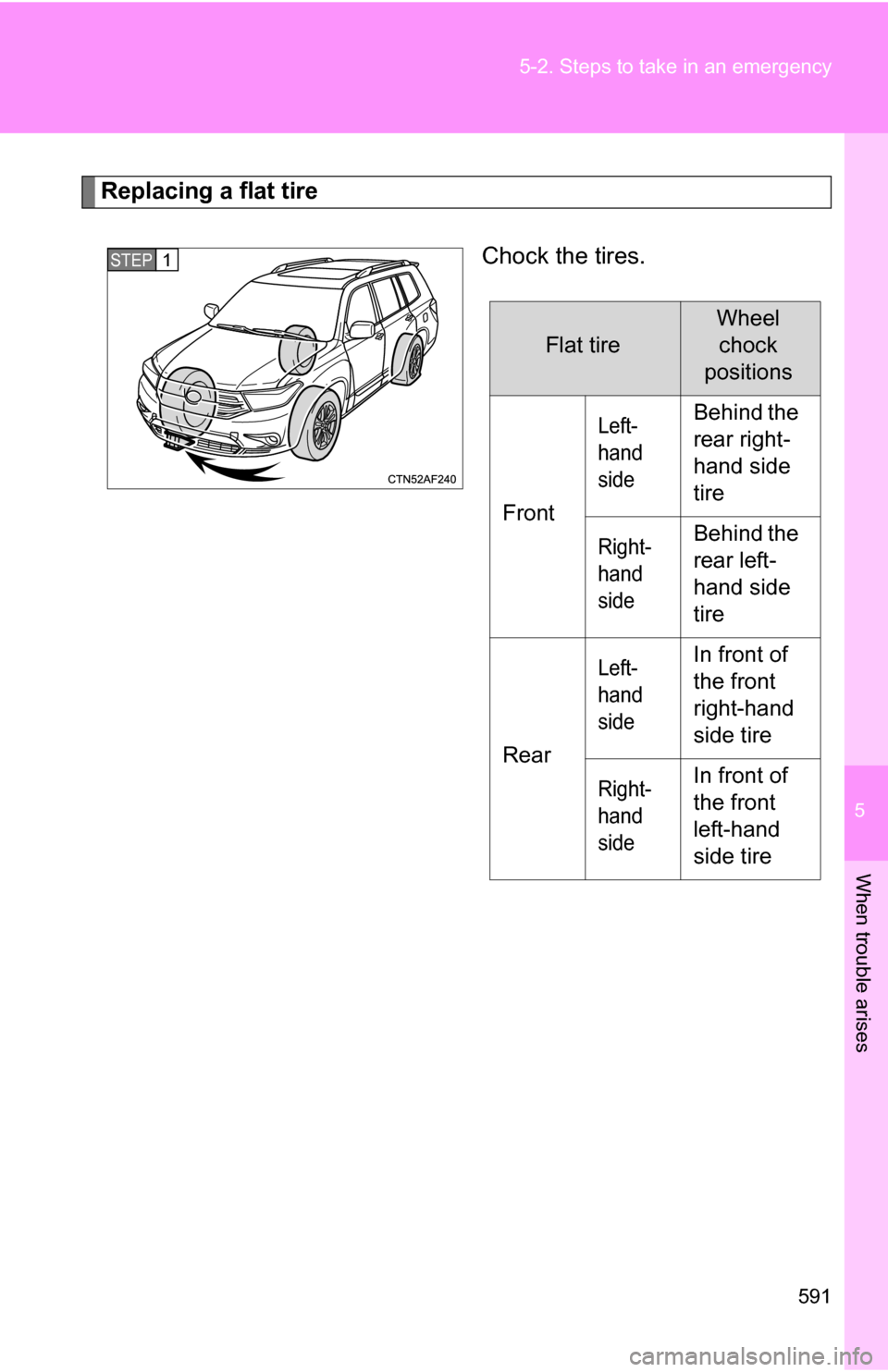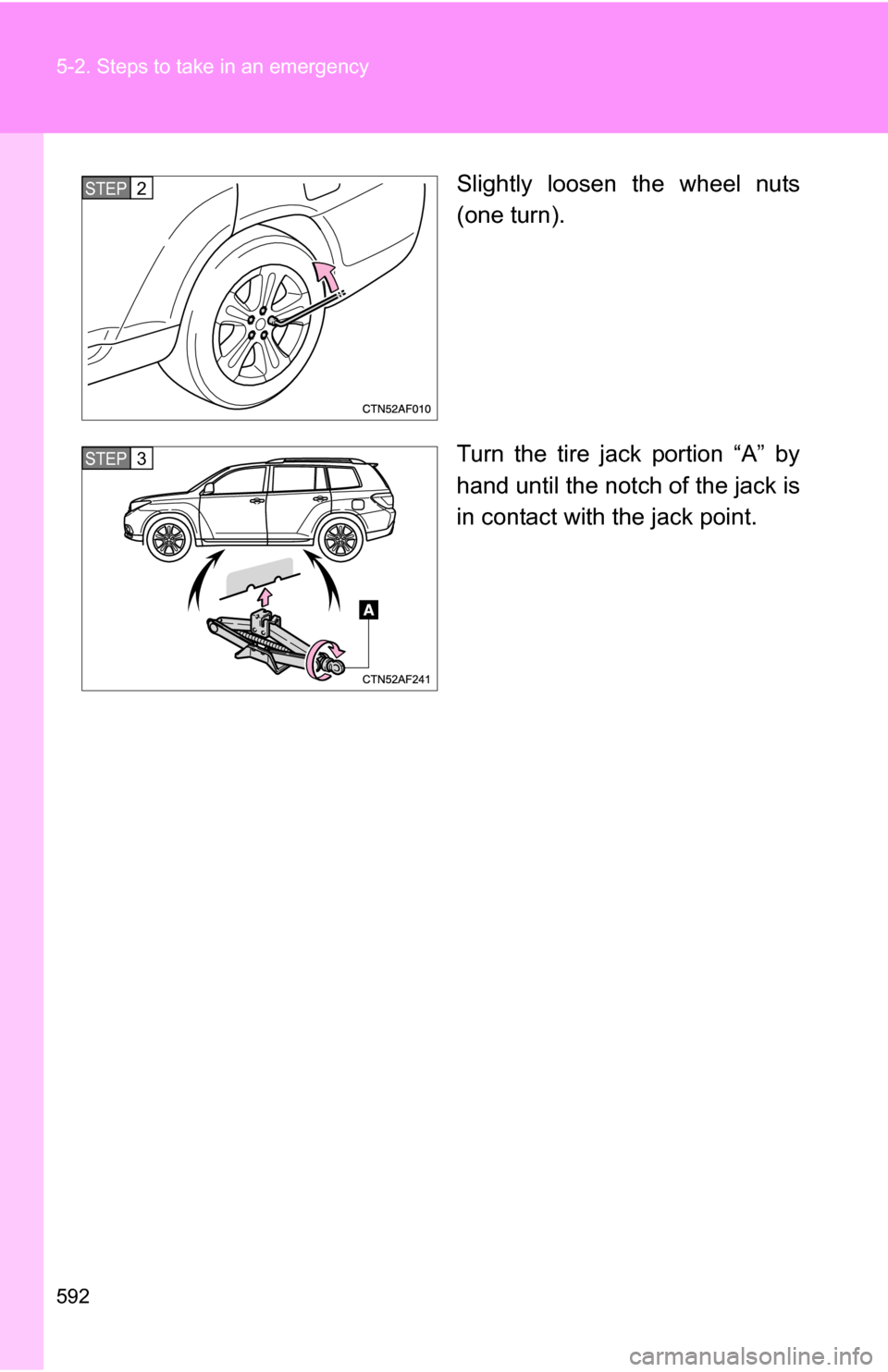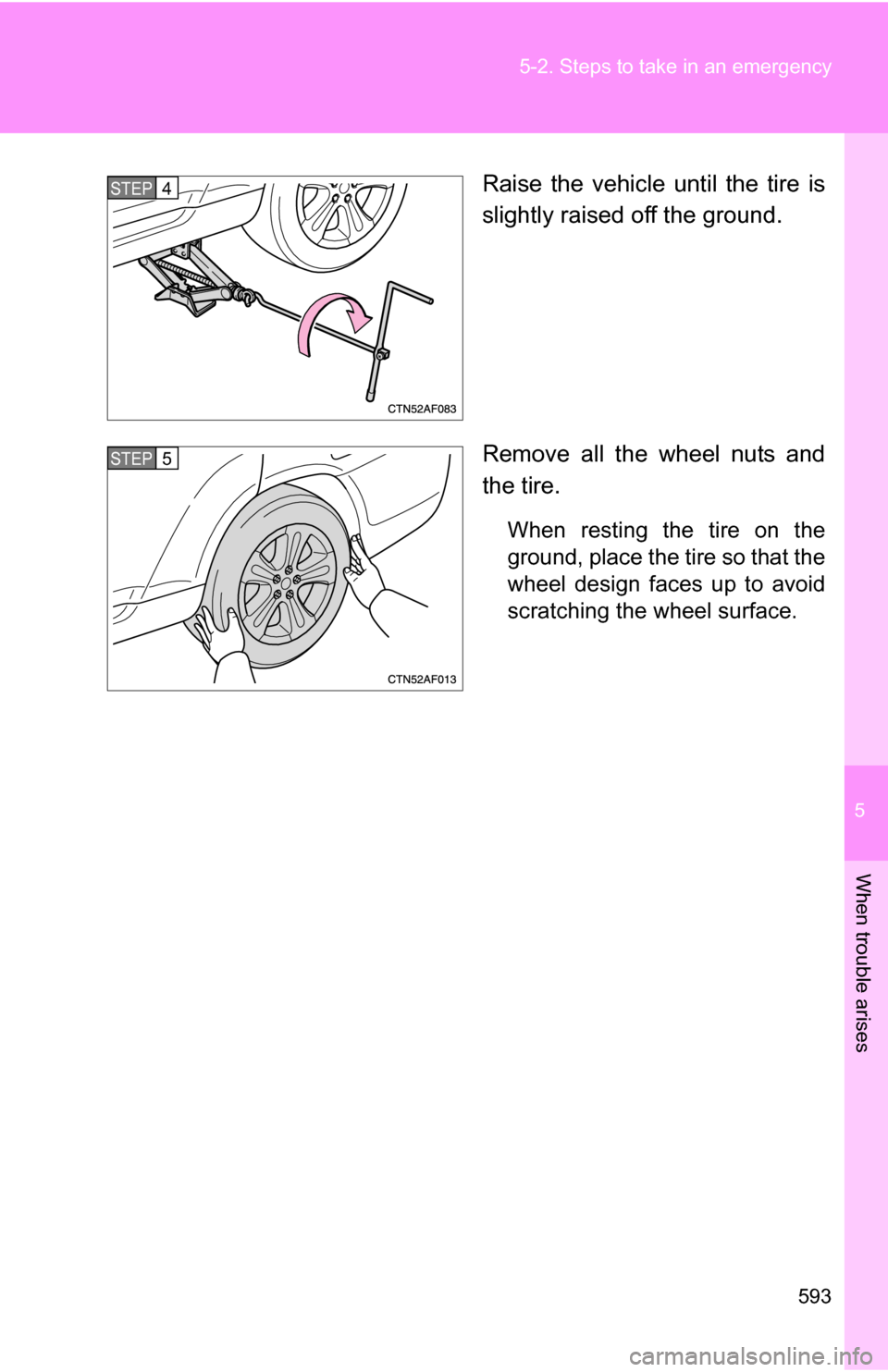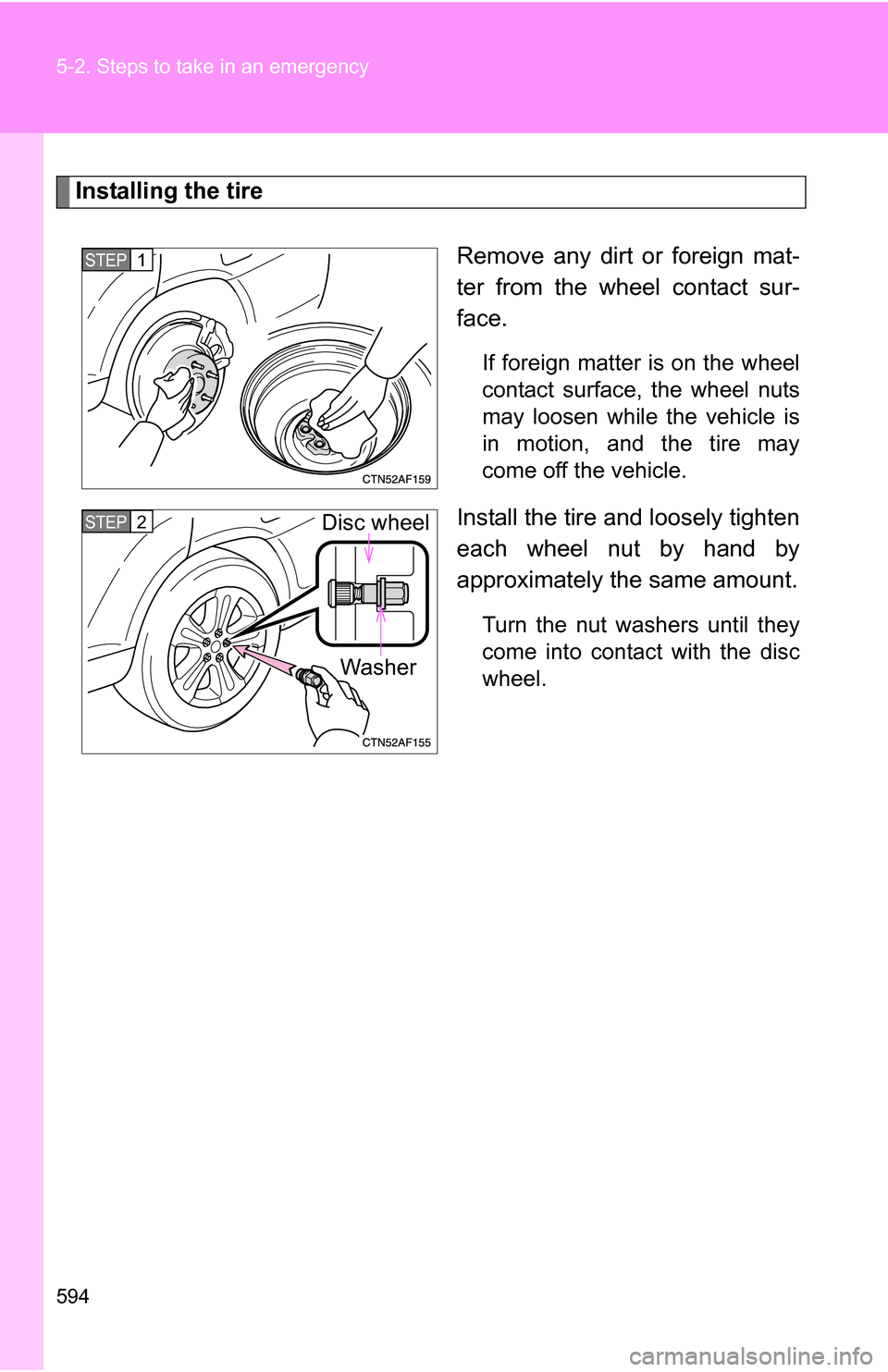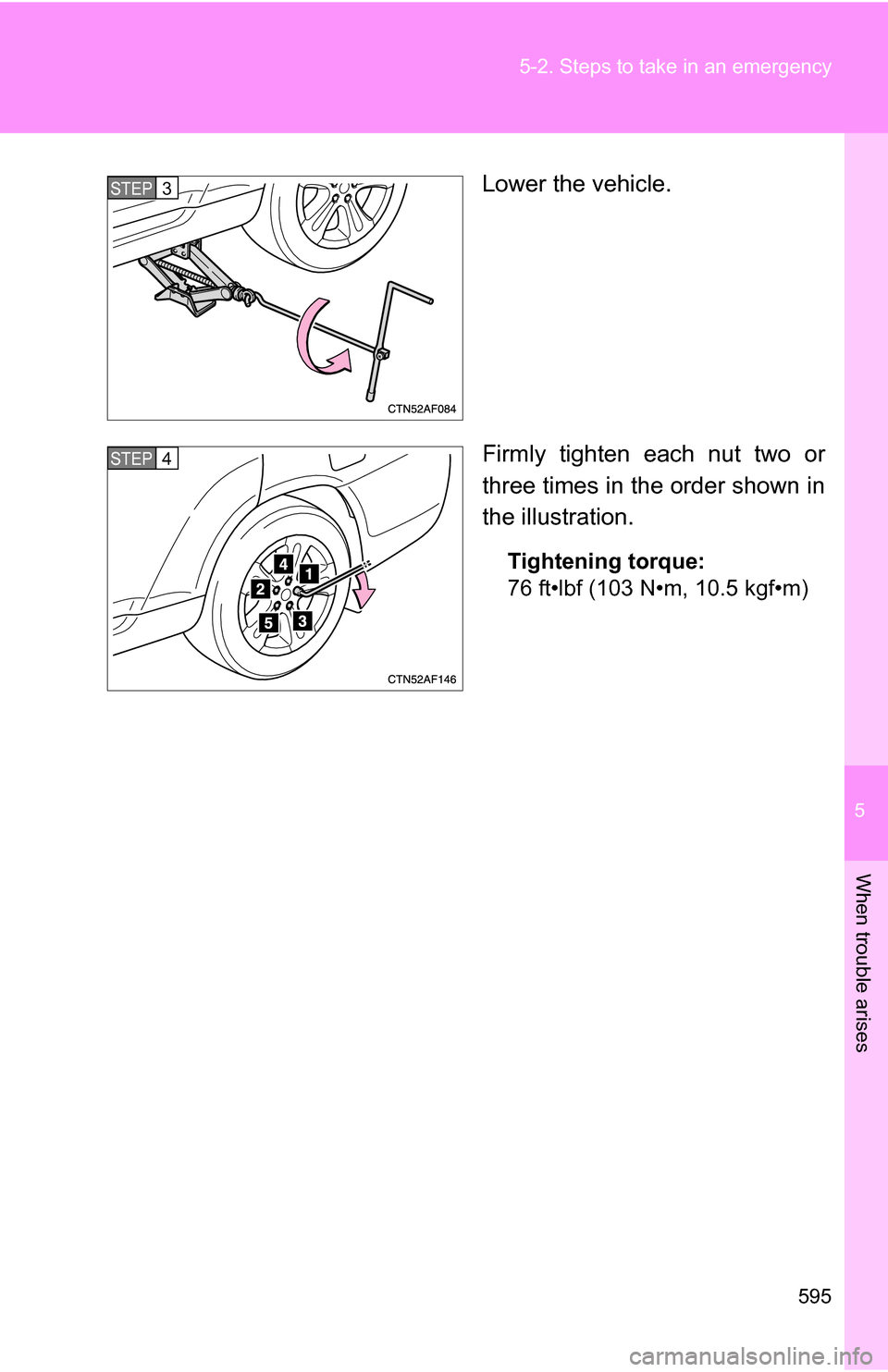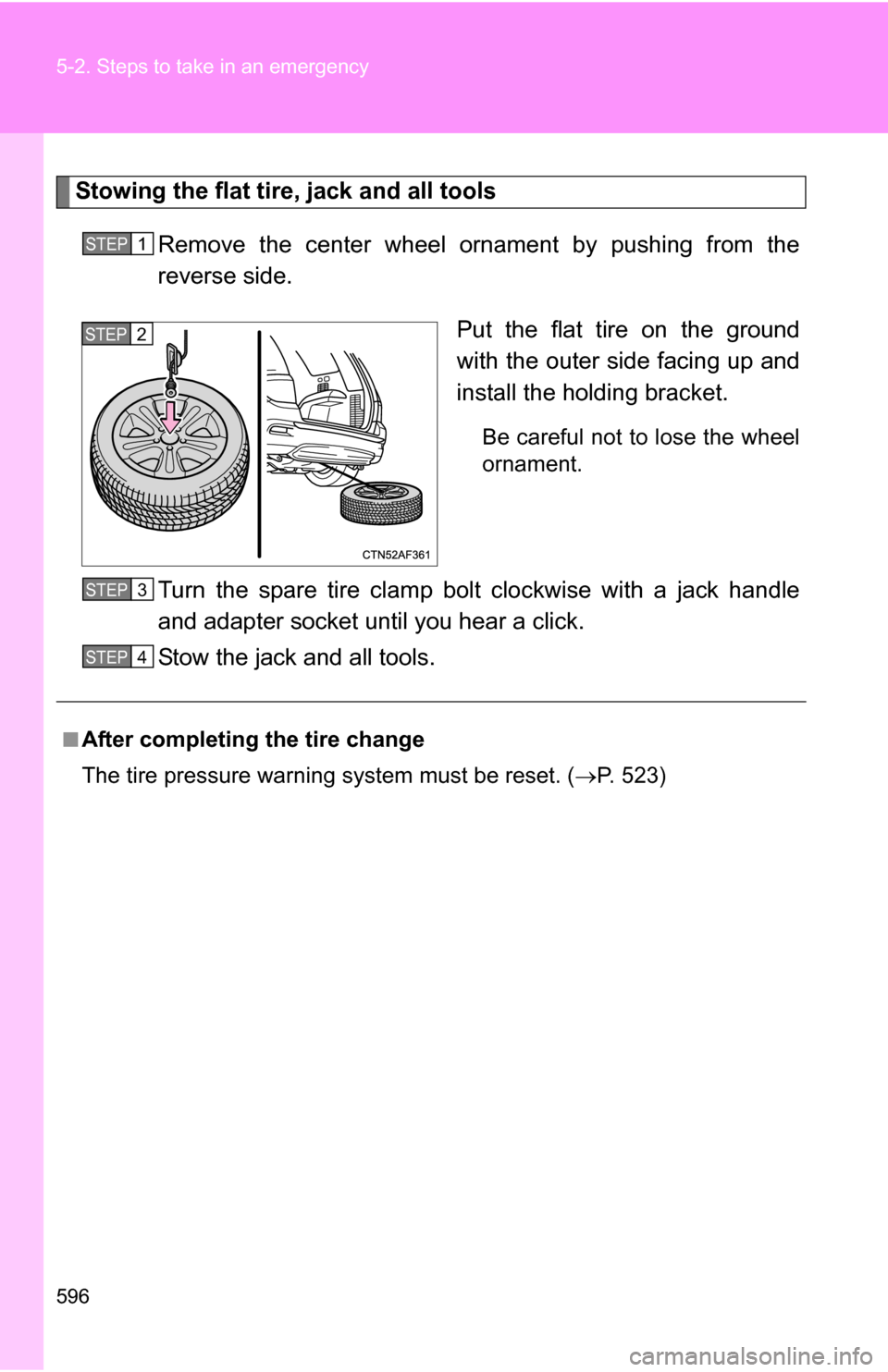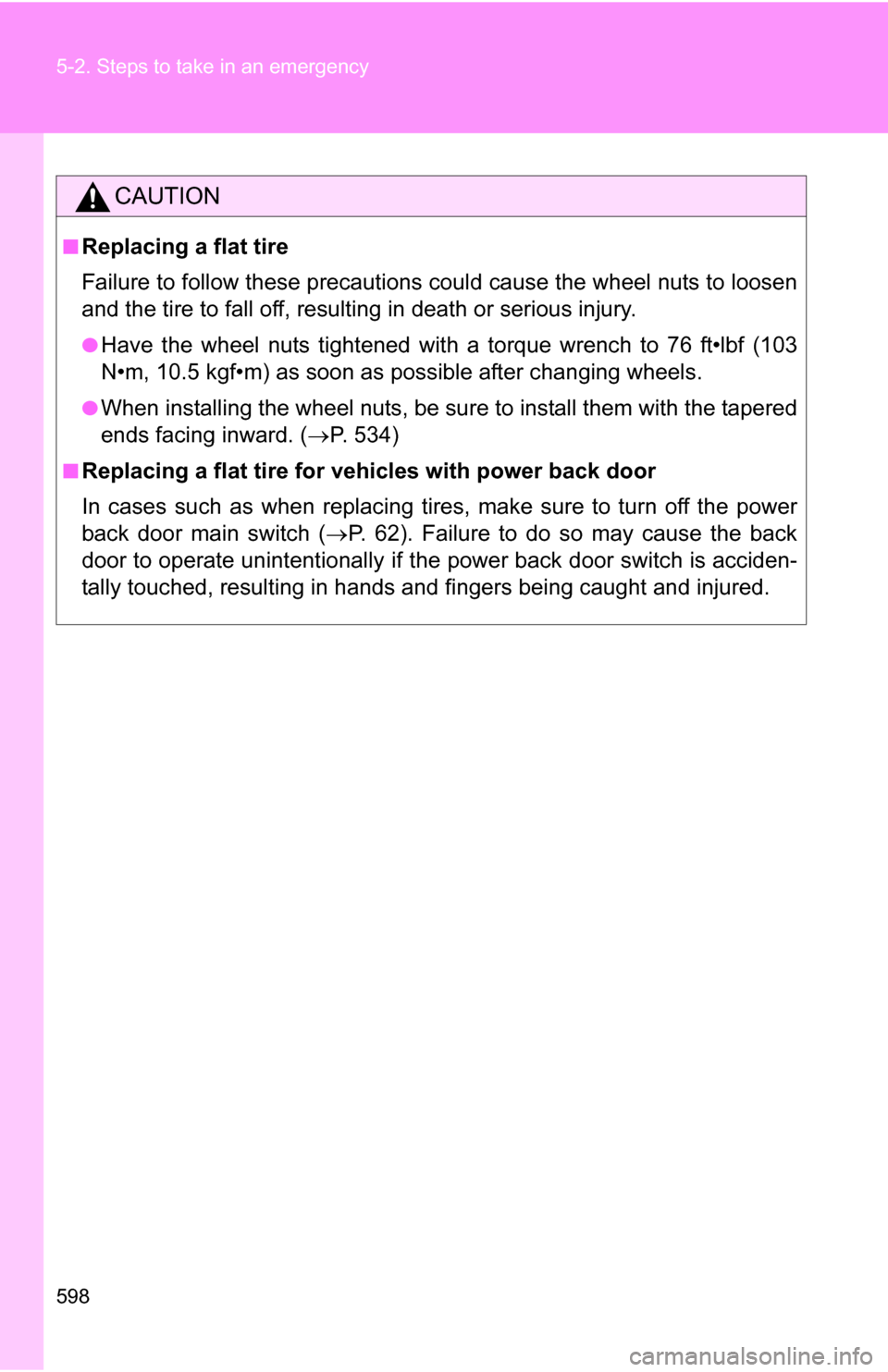TOYOTA HIGHLANDER 2013 XU50 / 3.G Owners Manual
HIGHLANDER 2013 XU50 / 3.G
TOYOTA
TOYOTA
https://www.carmanualsonline.info/img/14/6413/w960_6413-0.png
TOYOTA HIGHLANDER 2013 XU50 / 3.G Owners Manual
Trending: high beam, instrument cluster, check transmission fluid, fuel consumption, warning light, steering, oil viscosity
Page 591 of 684
5
When trouble arises
591
5-2. Steps to take in an emergency
Replacing a flat tire
Chock the tires.
STEP1STEP1
Flat tire
Wheel chock
positions
Front
Left-
hand
sideBehind the
rear right-
hand side
tire
Right-
hand
sideBehind the
rear left-
hand side
tire
Rear
Left-
hand
sideIn front of
the front
right-hand
side tire
Right-
hand
sideIn front of
the front
left-hand
side tire
Page 592 of 684
592 5-2. Steps to take in an emergency
Slightly loosen the wheel nuts
(one turn).
Turn the tire jack portion “A” by
hand until the notch of the jack is
in contact with the jack point.STEP2
STEP3
Page 593 of 684
5
When trouble arises
593
5-2. Steps to take in an emergency
Raise the vehicle until the tire is
slightly raised off the ground.
Remove all the wheel nuts and
the tire.
When resting the tire on the
ground, place the tire so that the
wheel design faces up to avoid
scratching the wheel surface.
STEP4
STEP5
Page 594 of 684
594 5-2. Steps to take in an emergency
Installing the tireRemove any dirt or foreign mat-
ter from the wheel contact sur-
face.
If foreign matter is on the wheel
contact surface, the wheel nuts
may loosen while the vehicle is
in motion, and the tire may
come off the vehicle.
Install the tire and loosely tighten
each wheel nut by hand by
approximately the same amount.
Turn the nut washers until they
come into contact with the disc
wheel.
STEP1
Disc wheel
WasherSTEP2
Page 595 of 684
5
When trouble arises
595
5-2. Steps to take in an emergency
Lower the vehicle.
Firmly tighten each nut two or
three times in the order shown in
the illustration.
Tightening torque:
76 ft•lbf (103 N•m, 10.5 kgf•m)
STEP3
STEP4
Page 596 of 684
596 5-2. Steps to take in an emergency
Stowing the flat tire, jack and all toolsRemove the center wheel ornament by pushing from the
reverse side. Put the flat tire on the ground
with the outer side facing up and
install the holding bracket.
Be careful not to lose the wheel
ornament.
Turn the spare tire clamp bolt clockwise with a jack handle
and adapter socket until you hear a click.
Stow the jack and all tools.
STEP1
STEP2
■After completing the tire change
The tire pressure warning system must be reset. ( P. 523)
STEP3
STEP4
Page 597 of 684
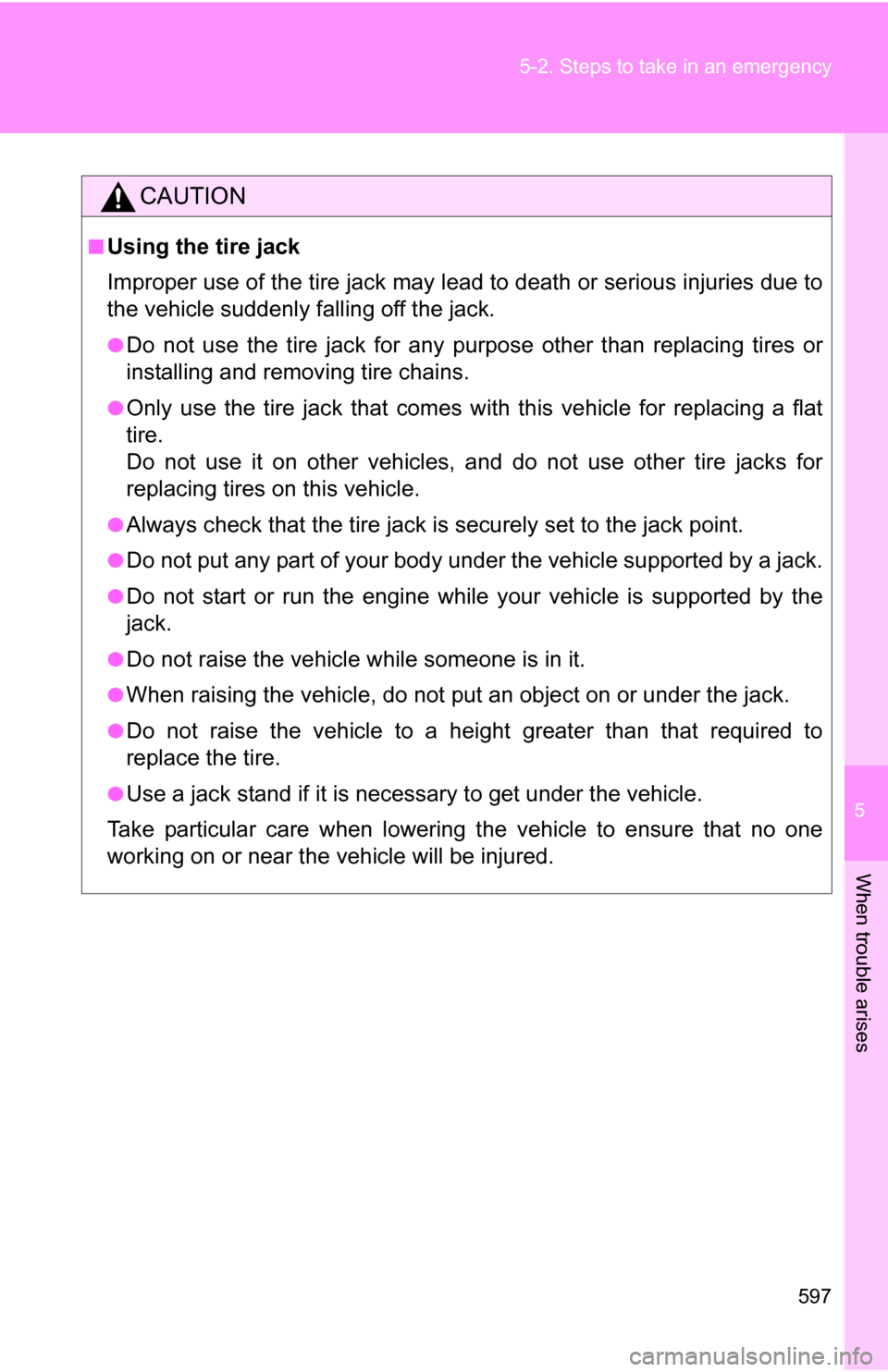
5
When trouble arises
597
5-2. Steps to take in an emergency
CAUTION
■Using the tire jack
Improper use of the tire jack may lead to death or serious injuries due to
the vehicle suddenly falling off the jack.
●Do not use the tire jack for any pu
rpose other than replacing tires or
installing and removing tire chains.
●Only use the tire jack that comes wi th this vehicle for replacing a flat
tire.
Do not use it on other vehicles, and do not use other tire jacks for
replacing tires on this vehicle.
●Always check that the tire jack is securely set to the jack point.
●Do not put any part of your body under the vehicle supported by a jack.
●Do not start or run the engine while your vehicle is supported by the
jack.
●Do not raise the vehicle while someone is in it.
●When raising the vehicle, do not put an object on or under the jack.
●Do not raise the vehicle to a hei ght greater than that required to
replace the tire.
●Use a jack stand if it is necessary to get under the vehicle.
Take particular care when lowering the vehicle to ensure that no one
working on or near the vehicle will be injured.
Page 598 of 684
598 5-2. Steps to take in an emergency
CAUTION
■Replacing a flat tire
Failure to follow these precautions could cause the wheel nuts to loosen
and the tire to fall off, resulting in death or serious injury.
●Have the wheel nuts tightened with a torque wrench to 76 ft•lbf (103
N•m, 10.5 kgf•m) as soon as possible after changing wheels.
●When installing the wheel nuts, be su re to install them with the tapered
ends facing inward. ( P. 534)
■Replacing a flat tire for vehicles with power back door
In cases such as when re placing tires, make sure to turn off the power
back door main switch ( P. 62). Failure to do so may cause the back
door to operate unintentionally if the power back door switch is acciden-
tally touched, resulting in hands and fingers being caught and injured.
Page 599 of 684
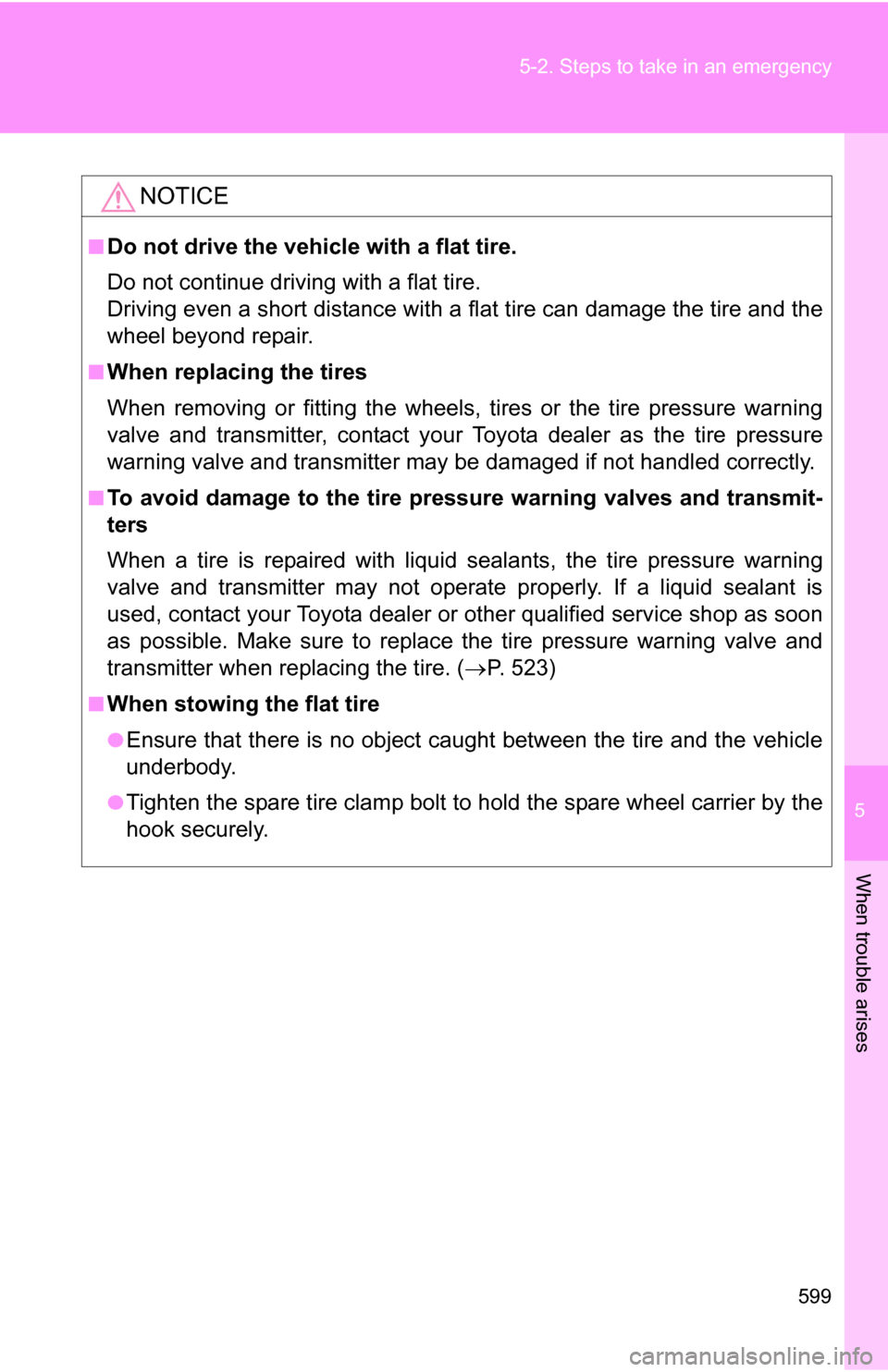
5
When trouble arises
599
5-2. Steps to take in an emergency
NOTICE
■Do not drive the vehicle with a flat tire.
Do not continue driving with a flat tire.
Driving even a short distance with a flat tire can damage the tire and the
wheel beyond repair.
■When replacing the tires
When removing or fitting the wheels, tires or the tire pressure warning
valve and transmitter, contact your
Toyota dealer as the tire pressure
warning valve and transmitter may be damaged if not handled correctly.
■To avoid damage to the tire pressure warning valves and transmit-
ters
When a tire is repaired with liquid sealants, the tire pressure warning
valve and transmitter may not operate properly. If a liquid sealant is
used, contact your Toyota dealer or other qualified service shop as soon
as possible. Make sure to replace the tire pressure warning valve and
transmitter when replacing the tire. ( P. 523)
■When stowing the flat tire
●Ensure that there is no object caught between the tire and the vehicle
underbody.
●Tighten the spare tire clamp bolt to hold the spare wheel carrier by the
hook securely.
Page 600 of 684
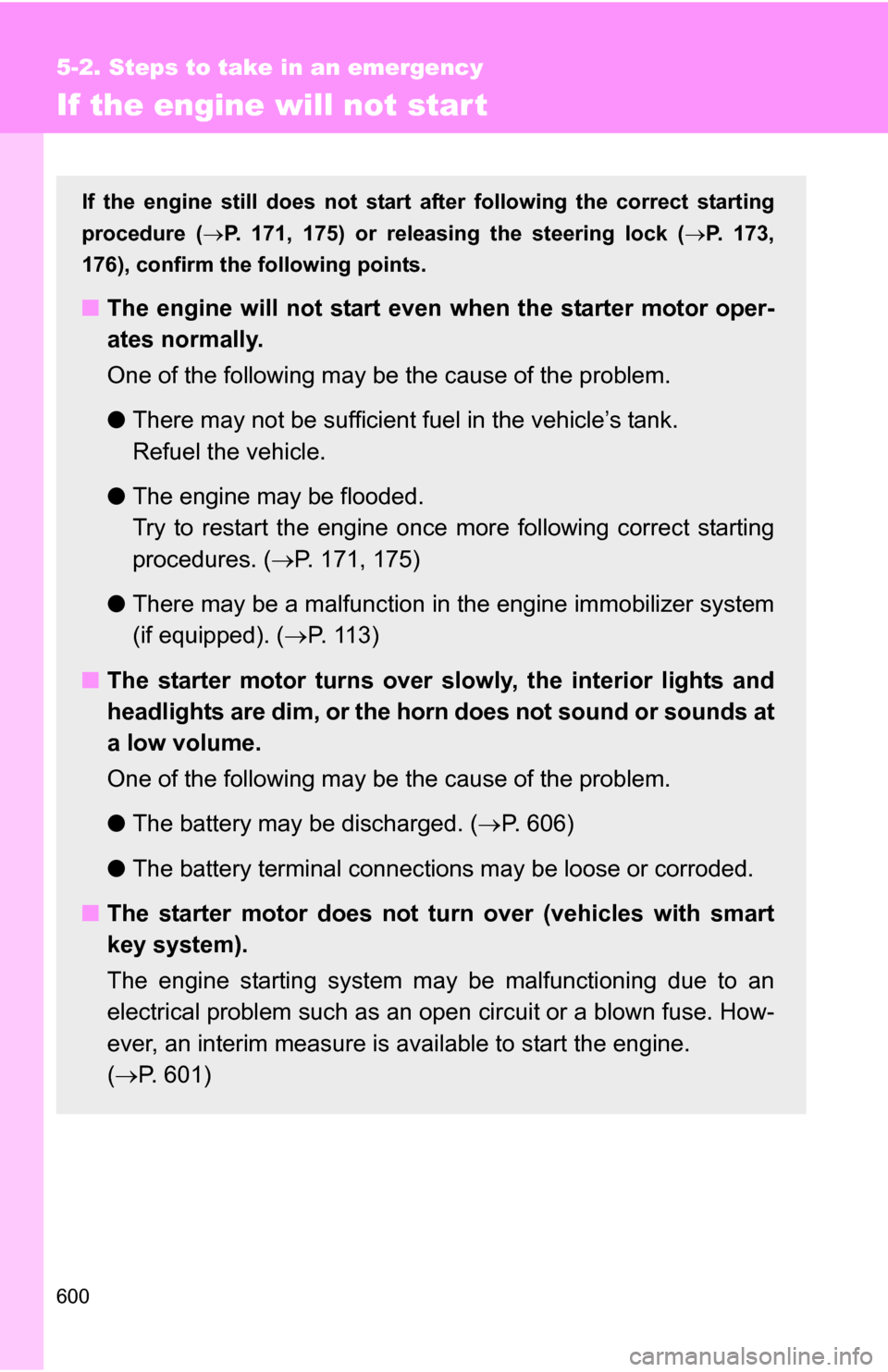
600
5-2. Steps to take in an emergency
If the engine will not star t
If the engine still does not start after following the correct starting
procedure (P. 171, 175) or releasing the steering lock ( P. 173,
176), confirm the fo llowing points.
■The engine will not start even when the starter motor oper-
ates normally.
One of the following may be the cause of the problem.
●There may not be sufficient fuel in the vehicle’s tank.
Refuel the vehicle.
● The engine may be flooded.
Try to restart the engine once more following correct starting
procedures. ( P. 171, 175)
● There may be a malfunction in the engine immobilizer system
(if equipped). ( P. 11 3 )
■ The starter motor turns over slowly, the interior lights and
headlights are dim, or the horn does not sound or sounds at
a low volume.
One of the following may be the cause of the problem.
●The battery may be discharged. ( P. 606)
● The battery terminal connec tions may be loose or corroded.
■ The starter motor does not turn over (vehicles with smart
key system).
The engine starting system may be malfunctioning due to an
electrical problem such as an open circuit or a blown fuse. How-
ever, an interim measure is available to start the engine.
( P. 601)
Trending: display, immobilizer, check engine light, coolant temperature, OBD port, brake pads, phone
